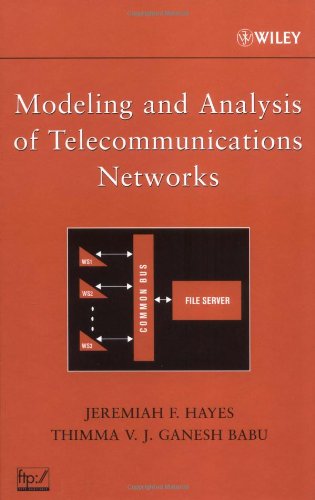Jeremiah F. Hayes, Thimma V. J. Ganesh Babu9780471348450, 0-471-34845-7
Table of contents :
Team DDU……Page 1
Copyright……Page 5
Content……Page 8
Preface……Page 14
Retrieving Files from the Wiley FTP and Internet Sites……Page 20
1.1.1 Customer Premises Equipment……Page 22
1.1.2 The Local Network……Page 23
1.1.4 Switching……Page 25
1.1.5 The Functional Organization of Network Protocols……Page 27
1.2 Approaches to Performance Evaluation……Page 29
1.3.1 Basic Form……Page 30
1.3.2 A Brief Historical Sketch……Page 31
1.4 Computational Tools……Page 34
Further Reading……Page 35
2.1.1 Set Functions and the Axioms of Probability……Page 38
2.1.2 Conditional Probability and Independence……Page 41
2.1.3 The Law of Total Probability and Bayes?¡¥ Rule……Page 42
2.2.1 The Cumulative Distribution Function……Page 43
2.2.2 Discrete Random Variables……Page 44
2.2.3 Continuous Random Variables……Page 52
2.3.1 Probability Distributions……Page 59
2.3.2 Joint Moments……Page 61
2.3.3 Autocorrelation and Autocovariance Functions……Page 62
2.4.2 Sums of Random Variables……Page 63
2.5 Transformed Distributions……Page 67
2.6 Inequalities and Bounds……Page 68
2.7.1 The Memoryless Property……Page 73
2.7.2 State Transition Matrix……Page 74
2.7.3 Steady-State Distribution……Page 77
2.8.2 Stationarity and Ergodicity……Page 82
2.8.3 Markov Processes……Page 84
Exercises……Page 85
3.1 Elements of the Queueing Model……Page 88
3.2.1 A Heuristic……Page 90
3.2.2 Graphical Proof……Page 91
3.2.3 Basic Relationship for the Single-Server Queue……Page 94
3.3.1 Basic Properties……Page 95
3.3.2 Alternative Characterizations of the Poisson Process……Page 96
3.3.3 Adding and Splitting Poisson Processes……Page 99
3.3.4 Pure Birth Processes……Page 100
3.3.5 Poisson Arrivals See Time Averages (PASTA)……Page 102
3.4.1 Steady-State Solution……Page 103
3.4.2 Queueing Models……Page 106
3.4.3 The M/M/1 Queue?aIn?nite Waiting Room……Page 107
3.4.4 The M/M/1/L Queue?aFinite Waiting Room……Page 110
3.4.5 The M/M/S Queue?aIn?nite Waiting Room……Page 112
3.4.6 The M/M/S/L Queue?aFinite Waiting Room……Page 116
3.4.7 Finite Sources……Page 118
3.5.1 Laplace Transform and Averages……Page 119
3.5.2 Insensitivity Property of Erlang B……Page 121
3.5.3 The Erlang B Blocking Formula: N Lines Homogeneous Traf?c……Page 124
Exercises……Page 127
4.1 Introduction: Jackson Networks……Page 134
4.2.1 Reversibility De?ned……Page 135
4.2.2 Reversibility and Birth and Death Processes……Page 137
4.2.3 Departure Process from the M/M/S Queue: Burke?¡¥s Theorem……Page 139
4.3.1 A Two-Node Example……Page 140
4.3.2 Feedforward Networks: Application of Burke?¡¥s Theorem……Page 141
4.3.3 The Traf?c Equation……Page 142
4.4.1 Flows Within Feedback Paths……Page 144
4.4.2 Detailed Derivation for a Two-Node Network……Page 145
4.4.3 N-Node Open Jackson Networks……Page 148
4.4.4 Average Message Delay in Open Networks……Page 153
4.4.5 Store-and-Forward Message-Switched Networks……Page 155
4.4.6 Capacity Allocation……Page 159
4.5.1 Traf?c Equation……Page 160
4.5.2 Global Balance Equation?aSolution……Page 162
4.5.3 Normalization Constant?aConvolution Algorithm……Page 163
4.5.4 Extension to the In?nite Server Case……Page 167
4.5.5 Mean Value Analysis of Closed Chains……Page 168
4.5.6 Application to General Networks……Page 170
4.6.1 Overview of BCMP Networks……Page 171
4.6.2 Single Node?aExponential Server……Page 172
4.6.3 Single Node?aIn?nite Server……Page 173
4.6.4 Single Node?aProcessor Sharing……Page 177
4.6.5 Single Node?aLast Come First Served (LCFS)……Page 179
4.7 Networks of BCMP Queues……Page 182
4.7.1 Store-and-Forward Message-Switched Nodes……Page 184
4.7.2 Example: Window Flow Control?aA Closed Network Model……Page 191
4.7.3 Cellular Radio……Page 196
References……Page 199
Exercises……Page 200
5.1 Time-Division Multiplexing……Page 208
5.2.1 Packetization……Page 209
5.2.2 Compound Arrivals……Page 210
5.3 Asynchronous Time-Division Multiplexing……Page 211
5.3.1 Finite Buffer……Page 213
5.3.2 In?nite Buffer……Page 216
5.4 Synchronous Time-Division Multiplexing……Page 218
5.4.1 Application of Rouche?¡¥s Theorem……Page 220
5.4.2 Calculations Involving Rouche?¡¥s Theorem……Page 222
5.4.3 Message Delay……Page 224
5.5.1 Introduction to ALOHA……Page 228
5.5.2 Analysis of Delay……Page 231
References……Page 236
Exercises……Page 237
6.1 The M/G/1 Queue……Page 240
6.1.1 Imbedded Markov Chains……Page 241
6.1.2 Distribution of Message Delay: FCFS……Page 243
6.1.3 Residual Life Distribution: Alternate Derivation of the Pollaczek¡§CKhinchin Formula……Page 252
6.1.4 Variation for the Initiator of a Busy Period……Page 255
6.1.5 Busy Period of the M/G/1 Queue……Page 258
6.2 The G/M/1 Queue……Page 262
6.3 Priority Queues……Page 265
6.3.1 Preemptive Resume Discipline……Page 266
6.3.2 L-Priority Classes……Page 273
6.3.3 Nonpreemptive Priorities……Page 277
6.4.1 Basic Model: Applications……Page 286
6.4.3 Average Delay: Exhaustive Gated and Limited Service……Page 288
References……Page 295
Exercises……Page 296
7.1.1 Single Source……Page 302
7.1.2 Multiple Sources……Page 305
7.2.1 The Differential Equation for Buffer Occupancy……Page 307
7.2.2 Derivation of Eigenvalues……Page 310
7.2.3 Derivation of the Eigenvectors……Page 313
7.2.4 Derivation of Coef?cients……Page 316
7.3 Finite Buffers……Page 319
7.5 Analysis: Leaky Bucket……Page 321
7.6 Equivalent Bandwidth……Page 324
7.7.1 De?nitions……Page 325
7.7.2 A Matching Technique for LRD Traf?c Using the Fluid Flow Model……Page 327
References……Page 330
Exercises……Page 331
8.2 Arrival Processes……Page 334
8.2.1 The Markov Modulated Poisson Process (MMPP)……Page 335
8.2.2 The Batch Markov Arrival Process……Page 337
8.2.4 Solutions of Forward Equation for the Arrival Process……Page 340
8.3.1 Revisiting the M/G/1 Queue……Page 342
8.3.2 The Multidimensional Case……Page 344
8.3.3 Application of Renewal Theory……Page 349
8.3.4 Moments at Message Departure……Page 355
8.3.5 Steady-State Queue Length at Arbitrary Points in Time……Page 356
8.3.7 Virtual Waiting Time……Page 357
8.4.1 d MMPPs and Equivalents……Page 358
8.4.2 A Fitting Algorithm……Page 360
Appendix 8A: Derivation of Several Basic Equations Used in Text……Page 364
Appendix 8B: Derivation of Variance and Covariance Functions of Two-State MMPP……Page 368
Exercises……Page 376
9.1.2 Sample Mean and Sample Variance……Page 380
9.1.3 Con?dence Intervals……Page 382
9.1.4 Sample Sizes and Run Times……Page 383
9.1.5 Histograms……Page 385
9.1.6 Hypothesis Testing and the Chi-Square Test……Page 389
9.2.1 Pseudorandom Numbers……Page 391
9.2.2 Generation of Continuous Random Variables……Page 392
9.2.3 Discrete Random Variables?aGeneral Case……Page 396
9.2.4 Generating Speci?c Discrete Random Variables……Page 398
9.2.5 The Chi-Square Test Revisited……Page 400
9.3.1 Time-Driven Simulation……Page 401
9.3.2 Event-Driven Simulation……Page 402
9.4 Variance Reduction Techniques……Page 403
9.4.1 Common Random-Number Technique……Page 404
9.4.2 Antithetic Variates……Page 405
9.4.3 Control Variates……Page 406
9.4.4 Importance Sampling……Page 407
Exercises……Page 408
Index……Page 410








Reviews
There are no reviews yet.